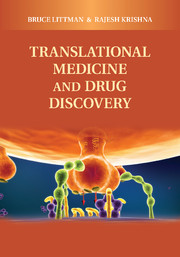Book contents
- Frontmatter
- Contents
- Contributors
- Preface
- Translational Medicine and Drug Discovery
- SECTION I TRANSLATIONAL MEDICINE: HISTORY, PRINCIPLES, AND APPLICATION IN DRUG DEVELOPMENT
- 1 TRANSLATIONAL MEDICINE: DEFINITION, HISTORY, AND STRATEGIES
- 2 TRANSLATIONAL MEDICINE AND ITS IMPACT ON DIABETES DRUG DEVELOPMENT
- 3 CHALLENGES IN ATHEROSCLEROSIS
- 4 OBESITY: NEW MECHANISMS AND TRANSLATIONAL PARADIGMS
- 5 BONE DISORDERS: TRANSLATIONAL MEDICINE CASE STUDIES
- 6 CASE STUDIES IN NEUROSCIENCE: UNIQUE CHALLENGES AND EXAMPLES
- 7 TRANSLATIONAL MEDICINE IN ONCOLOGY
- SECTION II BIOMARKERS AND PUBLIC–PRIVATE PARTNERSHIPS
- SECTION III FUTURE DIRECTIONS
- Index
- References
6 - CASE STUDIES IN NEUROSCIENCE: UNIQUE CHALLENGES AND EXAMPLES
Published online by Cambridge University Press: 04 April 2011
- Frontmatter
- Contents
- Contributors
- Preface
- Translational Medicine and Drug Discovery
- SECTION I TRANSLATIONAL MEDICINE: HISTORY, PRINCIPLES, AND APPLICATION IN DRUG DEVELOPMENT
- 1 TRANSLATIONAL MEDICINE: DEFINITION, HISTORY, AND STRATEGIES
- 2 TRANSLATIONAL MEDICINE AND ITS IMPACT ON DIABETES DRUG DEVELOPMENT
- 3 CHALLENGES IN ATHEROSCLEROSIS
- 4 OBESITY: NEW MECHANISMS AND TRANSLATIONAL PARADIGMS
- 5 BONE DISORDERS: TRANSLATIONAL MEDICINE CASE STUDIES
- 6 CASE STUDIES IN NEUROSCIENCE: UNIQUE CHALLENGES AND EXAMPLES
- 7 TRANSLATIONAL MEDICINE IN ONCOLOGY
- SECTION II BIOMARKERS AND PUBLIC–PRIVATE PARTNERSHIPS
- SECTION III FUTURE DIRECTIONS
- Index
- References
Summary
Why Is Neuroscience Not Tractable?
The discovery of novel therapies for the treatment of psychiatric and neurological disease faces one major hurdle beyond other therapeutic areas. The blood–brain barrier requires that most central nervous system (CNS) active drugs be reasonably lipophilic to reach their molecular target in the brain. Thus, understanding in vivo receptor occupancy has become an important part of most development programs in making terminantion (“no-go”) or continuation (“go”) decisions on progressing to a Phase 2 proof-of-concept study, especially when the drug in question is an antagonist or inhibitor of a transporter, enzyme, receptor, or ion channel. In these cases, at least 50% to 80% receptor occupancy at given doses, exposures, or both is usually required to attain demonstrable clinical efficacy (Fig. 6.1). When receptor occupancy studies are not available and maximally tolerated dose (MTD) strategies are executed, the success of this strategy is governed by the accuracy of defining the MTD.
The development of duloxetine provides an example of difficulties that may arise when an optimal biomarker is not available to define dose selection for initial efficacy studies. Initial efficacy testing for duloxetine in a Phase 1b/2 study of major depression was initiated in February 1993 using a 20-mg fixed dose. The completion date for the last patient enrolled in this study was November 1994. At that time no serotonin transporter (SERT) radiotracers were available that had been validated with the stringency needed for decision making.
- Type
- Chapter
- Information
- Translational Medicine and Drug Discovery , pp. 168 - 179Publisher: Cambridge University PressPrint publication year: 2011



